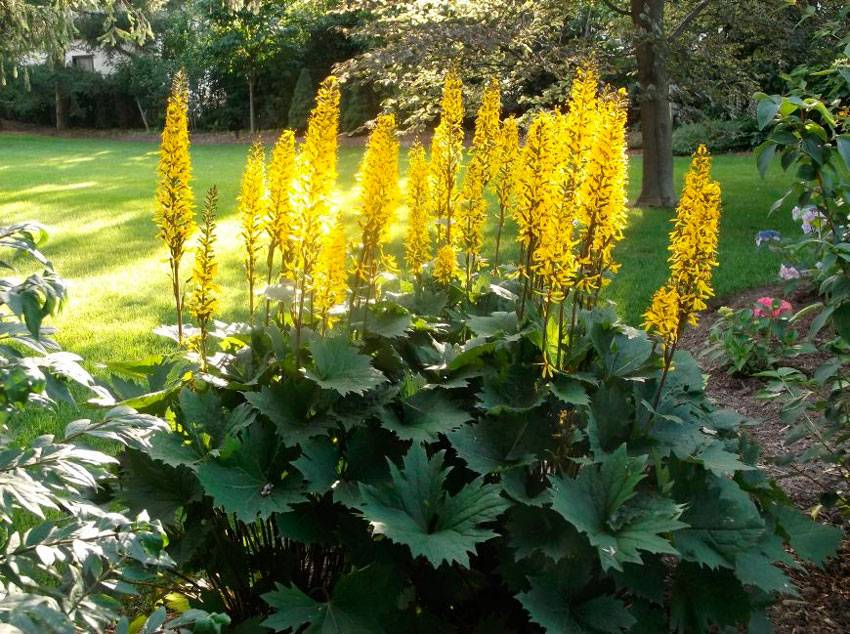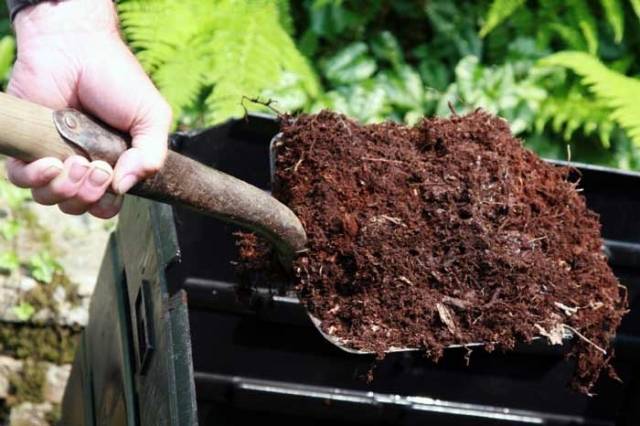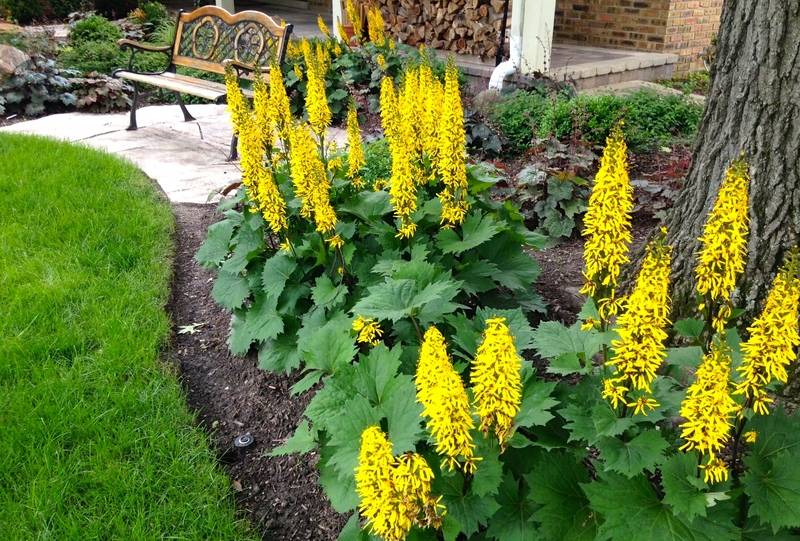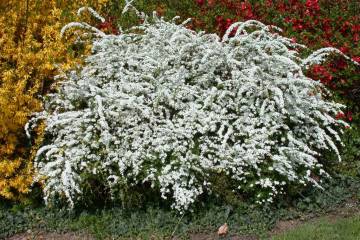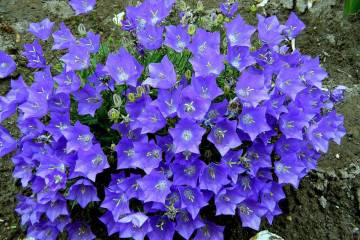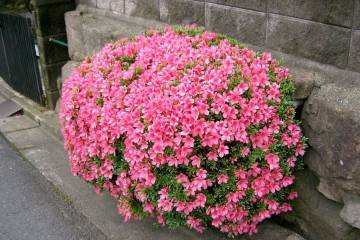Buzulnik Przewalski - planting and care
Content:
Buzulnik Przhevalsky got its name in honor of the famous Russian, member of the Academy of Sciences and traveler Nikolai Mikhailovich Przhevalsky. The scientific name of the bush used all over the world is Ligularia Przewalskii. The plant is widely known for its medicinal properties, therefore, its cultivation is widespread not only for decorative, but also for industrial purposes to create medicines and cosmetics.
Description Buzulnik Przewalski
Buzulnik Przewalski is a perennial plant of the Astrov family. The homeland of the bush is the southern territories of Europe, as well as East and South-West Asia. In Russia, in natural conditions, it grows in the central regions, especially in the Urals.
Buzulnik has a length of 1.5-2 meters. 1/3 of the height of the erect stems are covered with yellow fluffy inflorescences. The leaves of the bush are not located on the stem itself, they grow from a basal rosette.
Large and wide leaf plates are colored green with shades of purple or brown. They are heart-shaped, with slightly serrated edges and pubescence on the back.
Planting a plant
Before planting, you must choose the most favorable place for growing. Buzulnik does not really like constant sunlight, you should plant a bush in shaded areas.
Soil quality is another criterion when choosing a planting site. The soil should be loose and moist, so it is better to plant the plant in slightly low-lying places. Plots near various bodies of water, ponds and sprawling tall trees growing nearby are well suited.
Planting from seeds
After flowering, at the beginning of September, seeds begin to form in place of the buds, which can be collected and multiplied by a flower. The planting material must be thoroughly dried so that rotting does not begin, otherwise the germination rate will be very low.
Seeds can be sown in the same year in the fall or next spring. Sowing can be carried out immediately in open ground, in northern latitudes it is better to first plant it as seedlings in pots.
The seeds are buried 2-3 centimeters into the loose soil fertilized with organic matter. Seedlings should appear in the spring, after which they begin to look after the buzulnik in the usual way, since the plant is not particularly whimsical in growing.
Planting seedlings in open ground
If seedlings were first grown, then it is necessary to plant them in open ground in the spring. There are some rules to follow here.
A step-by-step description of the procedure for planting a przewalski buzulnik on a garden plot:
- Dig up the required area and add humus and wood ash to it.
- Dig holes 70 to 90 centimeters apart.
- Cover a layer of drainage material with a layer of up to 5 centimeters.
- Pour some fertilized soil over the drain.
- Plant the bushes in separate holes.
- Cover with loose and damp earth, tamp lightly.
- Water the bush with soft, slightly warm water.
After planting, it is recommended to mulch the buzulnik with dry foliage, peat, tree bark or other moisture-impermeable material.This procedure helps to reduce watering while retaining water in the soil, as well as getting rid of weeds and giving the flower garden a more pleasing appearance.
How to care for a Przewalski buzulnik
After planting Przewalski's buzulnik, and care must be carried out according to certain rules. Fortunately, even a novice florist is able to cope with it, since growing a plant does not cause any special worries. The main thing that you need to constantly take care of is regular and high-quality watering.
Watering
Watering should be given special attention. If the bush was planted next to a reservoir, then it is necessary to moisten the soil only during dry periods.
In other cases, the buzulnik is watered as soon as the soil surface begins to dry out. Therefore, mulching the soil can greatly facilitate this task. Towards autumn, watering is gradually reduced to avoid decay of the root system.
Top dressing
They begin to feed the bush already at planting. As a rule, the first spring and last autumn feeding are carried out using organic matter: humus, bird droppings, rotted manure or compost.
In the rest of the period, complex mineral fertilizers are used. For Buzulnik Przewalski, phosphorus-potassium preparations are especially necessary, which are most often used as superphosphate. About 60 grams of fertilizer is enough for 1 square meter.
Pruning
Pruning of Przewalski's buzulnik is carried out twice a season. The first time, the faded inflorescences of the bush are cut off, if necessary, leaving only a few pieces for subsequent reproduction by seeds.
The second pruning is more thorough. Before wintering at the bush, all the shoots are cut almost to the base in order to prepare it for wintering.
Reproduction methods
Reproduction is carried out mainly by sowing seeds and dividing the bush. The first method was described above, but it is not a popular method.
An adult bush is usually divided, the procedure is carried out before flowering. Buzulnik is dug up and the side parts are cut off with a sharp knife along with the root. Places of cuts are treated with activated carbon. The separated parts are planted in different holes.
Transfer
Transplants must be carried out every 5 years to renew the soil and rejuvenate the plant. For the same purpose, an adult buzulnik is propagated by dividing the bush. The procedure is recommended to be carried out in the spring, when it is easiest for the flower to adapt to new conditions.
Diseases and pests
Buzulnik Przewalski is characterized by high resistance to various kinds of diseases and pests. The bush can mainly suffer from poor-quality watering, when stagnant moisture in the soil provokes the appearance of root rot or an infectious fungus.
Rarely, powdery mildew may appear, due to which the foliage becomes covered with a white bloom. In the fight against diseases, fungicide treatment is especially effective.
Among the pests, the bush is affected by slugs, which are located on the back of the leaves and eat them. To destroy them, you need to use special chemicals or scatter superphosphate around the barrel. To prevent the appearance of slugs, experienced florists advise planting legumes in the vicinity of a buzulnik.
Flowering period
Przewalski's buzulnik begins to open its buds in the middle of summer, as a rule, in late June or early July. Flowering lasts until early September.
On tall and long peduncles, spikelet-shaped inflorescences appear, each of which has a diameter of about 10-20 centimeters. There are many small yellow flowers on them. First, the lower flower spikelets begin to form, and then bloom, after flowering, gradually and smoothly move up.
After the plant has completely bloomed in place of the buds, achenes with pappus appear, similar to small parachutes.
Preparing for winter
As soon as the first frost occurs, the last pruning of the bush is carried out. Cut off the entire ground part to the base. The rest is mulched with a thick layer of sawdust or bark, you can mix it with dry foliage.
Despite the fact that Przewalski's buzulnik is a frost-resistant plant, it is necessary to reinsure and cover it for the winter. Since with a lack of snow cover or a particularly cold winter, the bush can completely freeze and die. Therefore, from above it is covered with spruce branches.
Use in landscape design
Flowerbeds and flower beds are decorated with Przewalski's buzulnik. It is used to decorate the territory next to ponds, lakes, fountains. The plant looks good with tall, spreading trees, as well as next to tall ornamental deciduous shrubs with blue-green foliage.
Buzulnik Przewalski is able to decorate even the most unprepossessing and inconspicuous areas. A tall and sprawling plant ennobles areas with tall trees, giving them comfort. The plant is highly resistant to cold and disease, which is why it does not lose its beautiful appearance, even under adverse conditions.
